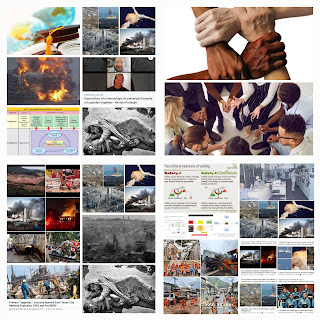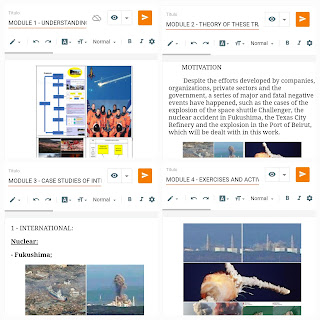Preliminary Analysis of Air India Flight AI 171 Accident from the Perspective of Major Accident Prevention through the Proactive Safety Approach
Preliminary Analysis of Air India Flight AI 171 Accident from the Perspective of Major Accident Prevention through the Proactive Safety Approach
**Abstract:** This article presents a preliminary analysis of the report on the Air India Flight AI 171 accident, a Boeing 787-8 Dreamliner, which occurred on June 12, 2025, in Ahmedabad, India. The report indicates a premature and simultaneous shutdown of both engines shortly after takeoff. Initial analysis suggests the possibility of inadvertent action or system failure, with significant implications for global aviation safety. We discuss the implications of these findings for safety management, exploring proactive safety models such as the **Structured Sociotechnical Approach**, **Dynamic Risk Management**, and the **Systemic View of Safety**.
**Keywords:** Aviation Accident, Flight Safety, Risk Management, Proactive Approach, Boeing 787.
-----
My deepest condolences to the families and friends of the victims.
The purpose of this article is to systematically analyze the risks involved in this accident and propose improvements in the management of this activity. It is not intended to assign blame or responsibility. The information presented here should not be used for purposes other than organizational learning, as it could lead to misinterpretations.
The analysis developed herein is theoretically grounded in Washington Ramos Barbosa's **Proactive Safety Approach (PSA) for the Prevention of Major Accidents**, which was the subject of a doctoral thesis in Production Engineering at COPPE/UFRJ (BARBOSA, 2023b).
-----
### **1. Introduction**
Aviation accidents, while rare, provide crucial insights for the continuous improvement of operational safety. The incident involving Air India Flight AI 171 on June 12, 2025, a Boeing 787-8 Dreamliner, is notable for its rapid progression and catastrophic outcome. This article synthesizes the preliminary findings of the investigation and discusses their relevance for the evolution of proactive safety strategies in aviation.
-----
### **2. Analysis of Preliminary Findings from Flight AI 171 Report**
The preliminary report on the Air India Flight AI 171 accident reveals a sequence of critical events that culminated in the aircraft's crash 32 seconds after takeoff (AAIB, 2025). The main points identified are:
* **Engine Shutdown:**
As per the EAFR data, the aircraft crossed the take-off decision speed V1 and achieved 153 kts IAS at 08:08:33 UTC. The Vr speed (155 kts) was achieved as per the EAFR at 08:08:35 UTC. The aircraft air/ground sensors transitioned to air mode, consistent with liftoff at 08:08:39 UTC.
The aircraft achieved the maximum recorded airspeed of 180 Knots IAS at about 08:08:42 UTC and immediately thereafter, the Engine 1 and Engine 2 fuel cutoff switches transitioned from RUN to CUTOFF position one after another with a time gap of 01 sec. The Engine N1 and N2 began to decrease from their take-off values as the fuel supply to the engines was cut off.
According to EAFR, Engine 1's fuel cutoff switch went from CUTOFF to RUN around 08:08:52 UTC. The APU gateway began opening at approximately 08:08:54 UTC, consistent with the logic of automatic start of the APU. Subsequently, at 08:08:56 UTC, the Engine 2 fuel cutoff switch also went from CUTOFF to RUN. When the fuel control switches are moved from CUTOFF to RUN while the aircraft is in flight, full authority dual engine control (FADEC) of each engine automatically manages a re-ignition and thrust recovery sequence from ignition and fuel introduction. EGT was observed to be increasing on both engines, indicating relighting. The slowdown of Engine core 1 stopped, reversed, and began progressing toward recovery. Engine 2 managed to reignite, but did not managed to stop the core speed slowdown and reintroduced fuel repeatedly to increase acceleration and core speed recovery. EAFR recording stopped at 08:09:11 UTC.
* **Cockpit Voice Recorder (CVR) Dialogue:** CVR recordings indicate a dialogue between the pilots, where one questions the other about cutting the engines, and the response denies the action, suggesting a possible inadvertent action or misunderstanding between crew members (AAIB, 2025).
* **Loss of Power and Crash:** The deployment of the Ram Air Turbine (RAT) confirmed a complete loss of electrical power. Although an attempt to restart engine 1 showed signs of recovery, engine 2 could not be re-established. The aircraft crashed approximately 0.9 nautical miles from the runway, impacting a housing complex, resulting in 241 fatalities on board and casualties on the ground (AAIB, 2025).
* **Operational and Environmental Conditions:** Thrust levers were found in the "idle" position; however, black box data indicated that takeoff thrust was still engaged, pointing to a possible disconnection between the physical command and the system's response. Fuel was tested and showed no contamination. Flaps (5 degrees) and landing gear (down) configurations were normal for takeoff. There were no reports of bird activity or adverse weather conditions; the weather was clear with good visibility and light winds (AAIB, 2025).
* **Crew and Maintenance:** Pilots' credentials and fitness were in order, and the crew was rested. The report mentioned a Federal Aviation Administration (FAA) airworthiness directive (AD) related to a potential failure in fuel cutoff switches, and it was noted that Air India had not performed the recommended inspections (AAIB, 2025; FAA, 2025). Sabotage was not identified as an immediate cause (AAIB, 2025).
-----
### **3. Proactive Safety Approaches in Aviation**
The analysis of incidents like Flight AI 171 reinforces the necessity of a proactive approach to safety management, where human factors and error are considered the "tip of the iceberg" of deeper systemic issues (BARBOSA, 2023b). Proactive safety aims to identify and mitigate risks before they result in accidents, utilizing a deep understanding of the complex interactions within a system (ICAO, 2025). Three models stand out in this context (BARBOSA, 2023a, 2023b):
#### **3.1. Structured Sociotechnical Approach**
This model recognizes that safety is a result of the complex interaction between technical components (aircraft, software) and social elements (crew, maintenance, procedures) (ICAO, 2025). Safety does not merely reside in the absence of technical failures but in the system's resilience in handling variations and disturbances. In the case of AI 171, the interaction between the pilots and engine control systems, as well as maintenance directives and their application, are clear examples of this interdependence. The failure to perform recommended inspections on critical switches can be seen as a gap in the sociotechnical interface (AAIB, 2025; FAA, 2025). The sociotechnical construction of resilience highlights the role of social, cultural, and ethical factors in safety (BARBOSA, 2023a).
#### **3.2. Dynamic Risk Management**
Safety is not a static state but a continuous process of adaptation. **Dynamic Risk Management (DRM)** focuses on an organization's ability to identify, assess, and mitigate risks in real-time, considering the evolution of operations and the environment (ICAO, 2025). This involves continuous data collection, predictive analysis, and the ability to adjust safety strategies as new information emerges. The pilots' discussion in the cockpit, for instance, illustrates a dynamic event where the risk sharply increased, demanding an immediate and coordinated response. DRM emphasizes the need for systems that allow crew and management to identify and respond to deviations from normal operation before they escalate into an accident (AAIB, 2025).
#### **3.3. Systemic View of Safety with Other Organizational Areas**
This model transcends the view of safety as an isolated function, integrating it with all areas of the organization: design, manufacturing, maintenance, training, operations, and even organizational culture (ICAO, 2025). Safety is seen as an emergent property of the system as a whole, where each department contributes to the overall safety level. The AI 171 incident exemplifies this necessity. The potential failure in fuel cutoff switches, combined with Air India's non-compliance with an airworthiness directive, demonstrates how decisions made in areas like maintenance and regulatory compliance directly impact the safety of flight operations (AAIB, 2025; FAA, 2025). An effective systemic view ensures that safety is a core and cross-cutting value, influencing all decisions and processes.
-----
### **4. Conclusion**
The preliminary report on the Air India Flight AI 171 accident offers valuable lessons for aviation safety (AAIB, 2025). Evidence points to a complex *interplay* of factors, including possible crew actions and maintenance compliance gaps. This event reinforces the premise that operational safety is an emergent phenomenon of complex sociotechnical systems. The adoption and enhancement of proactive approaches such as the **Structured Sociotechnical Approach**, **Dynamic Risk Management**, and the **Systemic View of Safety** are imperative to prevent future accidents, fostering a robust and adaptive safety culture throughout the aviation industry (BARBOSA, 2023a, 2023b; ICAO, 2025). The full investigation is crucial to elucidate all contributing factors and provide *insights* for improving global safety practices.
-----
### **5. References and Relevant Links**
AAIB. **Preliminary Report on Air India Flight AI 171 Accident**. Ahmedabad, India, 2025. Available at: [http://aaib.gov.in/](http://aaib.gov.in/). Accessed on: 11 Jul. 2025.
BARBOSA, Washington R. **Sociotechnical Construction of Resilience: The Role of Social, Cultural, and Ethical Factors**. Blog Gestão Proativa. 2023a. Available at: [https://gestaoproativawb.blogspot.com/2023/03/article-sociotechnical-construction-of.html](https://gestaoproativawb.blogspot.com/2023/03/article-sociotechnical-construction-of.html). Accessed on: 11 Jul. 2025.
BARBOSA, Washington R. **Training in the Prevention of Major Accidents through the Proactive Safety Approach**. 2023b. Available at: [https://www.researchgate.net/publication/386874829\_Training\_in\_the\_Prevention\_of\_Major\_Accidents\_through\_the\_Proactive\_Safety\_Approach](https://www.researchgate.net/publication/386874829_Training_in_the_Prevention_of_Major_Accidents_through_the_Proactive_Safety_Approach). Accessed on: 11 Jul. 2025.
FAA. **Airworthiness Directives**. 2025. Available at: [https://www.faa.gov/aircraft/air\_cert/airworthiness\_directives](https://www.google.com/search?q=https://www.faa.gov/aircraft/air_cert/airworthiness_directives). Accessed on: 11 Jul. 2025.
ICAO. **International Standards and Recommended Practices**. 2025. Available at: [https://www.icao.int/](https://www.icao.int/). Accessed on: 11 Jul. 2025.










Comentários
Postar um comentário